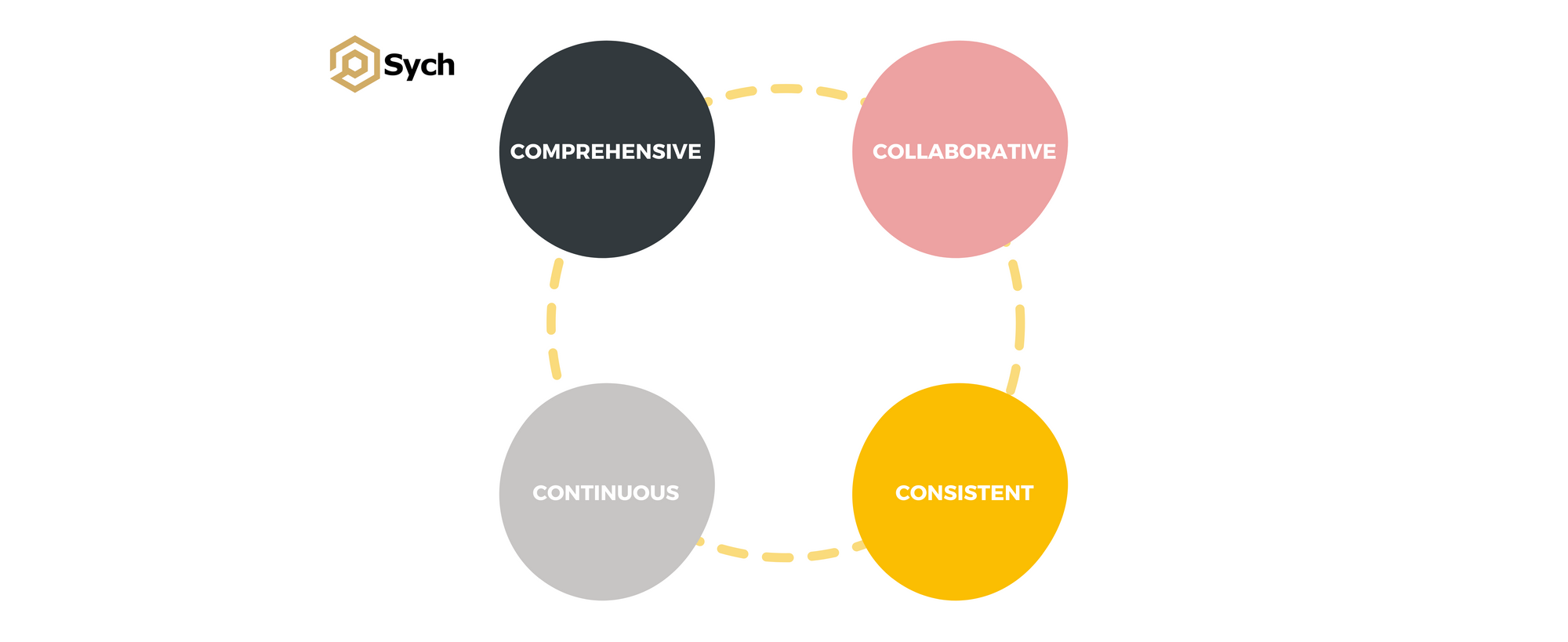The Gold Standard for Reviewing Code
Code reviews are an essential part of building high-quality software, but what makes a truly great code review? At Sych, we believe in the Gold Standard for reviewing code, which includes being comprehensive, collaborative, consistent, and continuous.

Introduction
Imagine you are a chef who has created a new dish that you are proud of. You carefully chose the ingredients, meticulously prepared them, and artfully plated the final product. But before you serve it to your customers, you invite other experienced chefs to taste and critique it. This is the equivalent of a code review in the software development world.
Just like how chefs have their own unique styles and tastes, developers have their own coding styles and preferences. Code reviews allow multiple developers to come together and share their perspectives on a codebase, identify areas of improvement, and ultimately improve the quality of the final product. Here at Sych, we have established a clear set of guidelines for code reviews, a Gold Standard to help us navigate the complexities of code evaluation. This gold standard is the foundation upon which all code reviews are conducted, ensuring that the code we produce is of the highest quality and meets the needs of our users.
What is the Gold Standard?
The gold standard of code reviews is a comprehensive and collaborative process of evaluating and improving code quality that goes beyond identifying and fixing errors. It involves a deep understanding of the project goals, the technical requirements, and the development team's capabilities. It requires a balance of technical expertise and soft skills, such as effective communication, empathy, and respect for different perspectives. It values continuous learning and improvement, and encourages a culture of trust, accountability, and transparency. It results in code that is not only functional and efficient, but also maintainable, scalable, and user-friendly. It ultimately leads to better products, happier customers, and more satisfied developers.
While there are many code-quality frameworks that focus on specific patterns or principles, few capture the broad checklist of attributes we use to evaluate code quality. That's why we developed the Gold Standard for reviewing code, which encompasses four overarching properties: Comprehensive, Collaborative, Consistent, and Continuous. By focusing on these key areas, teams can ensure that their code reviews are thorough, effective, and ultimately contribute to the success of their projects.

Comprehensive
A comprehensive code review means looking at every aspect of the code, not just the parts that are easy to see. This includes checking for code style and formatting, readability, performance, security, and functionality. It's important to go beyond just checking if the code works and to also consider if it is maintainable and scalable in the long run. Think of it like an annual physical check-up at the doctor's office - they don't just check your pulse and send you on your way, but conduct a thorough examination to catch any potential issues before they become bigger problems.
Questions to ask:
- Have you considered all aspects of the code, including readability, performance, security, and functionality?
- Is the code maintainable and scalable in the long run?
- Have you tested all possible edge cases and scenarios?
✅ Do
A developer is tasked with reviewing a colleague's code for a new feature. They take the time to not only check for functionality but also look at the code's style, formatting, and security. They also make sure that the code is scalable and maintainable in the long run. As a result, the code is cleaner, more organized, and easier to understand and maintain.
❌ Don't
A developer is asked to review a colleague's code but only checks if the code works without considering other aspects like style, formatting, and security. As a result, the code is functional but difficult to maintain and understand in the long run.
Collaborative
Code reviews shouldn't be a one-person job. Instead, it should be a collaborative effort where multiple team members contribute their expertise and insights to improve the code. This means involving developers, designers, and testers to ensure that all aspects of the code are evaluated from different perspectives. Collaboration also means creating a safe space for team members to provide constructive feedback without fear of retribution. Think of it like a brainstorming session where everyone's ideas are considered and valued.
Questions to ask:
- Have you involved multiple team members with different perspectives in the code review process?
- Have you created a safe space for team members to provide feedback without fear of retribution?
- Have you considered feedback from all team members before making a decision?
✅ Do
During a code review, a developer shares their expertise on code optimization and suggests improvements to the code's performance. The designer on the team provides feedback on the code's design and user interface, while the tester helps catch potential bugs. Together, they ensure that the code is well-rounded and ready for production.
❌ Don't
During a code review, a developer makes changes to the code without consulting with other team members. As a result, the code may have improved in one aspect but has overlooked other important aspects, leading to issues down the line.
Consistent
Consistency is key in creating maintainable and scalable code. Code reviews should ensure that code follows established patterns and conventions, adheres to best practices, and is consistent with the overall architecture of the project. This means paying attention to things like naming conventions, variable and function naming, and code organization. Consistency also means following the same review process for each code review to ensure that all code is evaluated in the same way. Think of it like following a recipe - the ingredients and steps need to be consistent to create a successful outcome.
Questions to ask:
- Does the code follow established patterns and conventions?
- Does the code adhere to best practices?
- Is the code consistent with the overall architecture of the project?
✅ Do
A team follows a set of established coding conventions and patterns for all of their projects. During a code review, they ensure that the code follows these conventions and adheres to the best practices. This leads to consistent code across projects that is easier to maintain and understand.
❌ Don't
A team does not follow established coding conventions and patterns, leading to inconsistencies across projects. During a code review, they do not check for consistency, leading to code that is difficult to maintain and understand.
Continuous
Code reviews should be an ongoing process, not just a one-time event. This means integrating code reviews into the development process and making it a regular part of the workflow. It also means using tools like automated testing and code analysis to continuously monitor the codebase for potential issues. Continuous code reviews help catch issues early on and ensure that the code is always improving. Think of it like maintaining a healthy lifestyle - it's not just about going to the gym once, but making it a consistent habit to see long-term benefits.
Questions to ask:
- Is the code review process integrated into the development workflow?
- Are automated testing and code analysis tools being used to continuously monitor the codebase?
- Are issues being caught and addressed early on to ensure continuous improvement?
✅ Do
A team integrates code reviews into their development process, making it a regular part of the workflow. They use tools like automated testing and code analysis to continuously monitor the codebase for potential issues. As a result, they catch issues early on and ensure that the code is always improving.
❌ Don't
A team only conducts code reviews as a one-time event, without integrating them into their development process. As a result, they may miss potential issues, leading to a lower-quality codebase.
Conclusion
Code reviews are an essential part of the software development process, and the Gold Standard provides a comprehensive checklist of attributes to ensure code quality. By following the principles of being comprehensive, collaborative, consistent, and continuous, teams can create maintainable, scalable, and high-quality code.
Remember, code reviews are not a one-person job, and involving multiple team members brings valuable insights and expertise to the table. Consistency is key in creating code that is easy to maintain, and continuously monitoring the codebase helps catch issues early on. By following the Gold Standard, teams can ensure that their code is of the highest quality and meets the needs of their users.
So, the next time you conduct a code review, ask yourself: Am I being comprehensive in my evaluation? Am I collaborating with my team members? Am I adhering to established conventions and practices? Am I making code reviews a continuous process? Answering these questions will not only improve your code quality but also enhance your development process.
If you're looking for a partner to help you implement these principles and improve your code quality, consider working with Sych. Our team of experienced developers can work with you to create bespoke software solutions that meet your business needs and adhere to the Gold Standard of code quality. Contact us today to learn more about how we can help your business grow and succeed.

